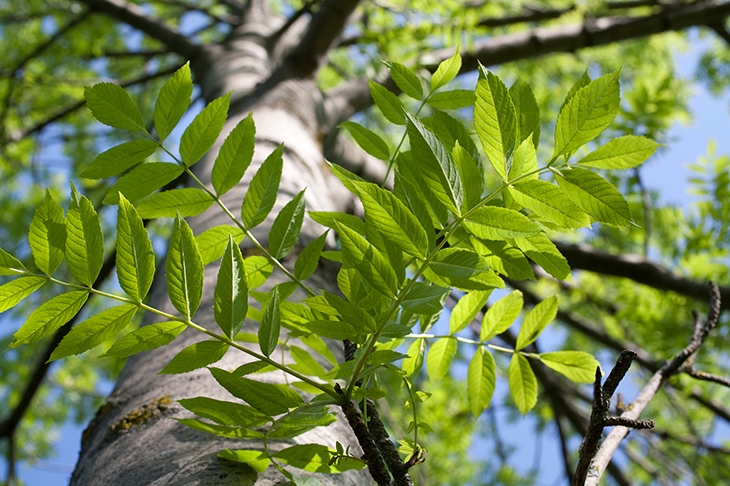Once we wrote poems when we lost our trees. Now we just watch them rot. In 1820 John Clare was moved to mark the end of a single tree he had loved: ‘It hoples Withers droops & dies.’ In 2020, so many English trees are dying that it would take a library of Clares to record the casualties.
This year, locked-down in Derbyshire, I have been watching skeletons amid the green, hoping that they will return to life. Almost all have. The last of the great field ashes are only just coming into leaf, scarred by late frosts and drought. A row of oaks I ride by most days has dead leaves that crunch in my fingers when I reach up from my horse. The frost got these too — but beneath the brown there are fresh shoots.
Little things like these ease the sadness that hits hard when I think of what is happening to our trees. As a child I can remember the dead elms standing out from hedgerows, and the shock of their loss was huge. Edward Heath’s government launched a campaign with a jaunty slogan: ‘Plant a tree in ’73.’ The echo came back — ‘Plant some more in ’74’ — but the elm went anyway: 60 million died in Britain. Their descendants struggle on as saplings. We have a few. But a fungus spread by the elm bark beetle gets them all before maturity.
Young shoots stick up from the ground, leafless and pockmarked; older trees are gappy, half-alive
Now it is the turn of the ash. When the Asian fungus Hymenoscyphus fraxineus (ash dieback) was first reported in England in October 2012, there were promises of task forces and action. But it kept spreading and now we talk about it less. It is in every English county and you can see the effects in almost every woodland. Young shoots stick up from the ground, leafless and pockmarked. Older trees struggle on, gappy, some half-alive. Forests have become diseased places, especially the ash woodlands of the English limestone uplands such as Dovedale, a place William Blake described in ‘Jerusalem’ as ‘draped’ in its ‘own perfect beauty’.
Dieback isn’t like elm disease: it is slow and not every tree will succumb. There is some hope. Scientists at Defra have told me of the record £6 million that has gone into ash research. The fungus has been studied. The ash tree’s genome has been sequenced.
Unlike elms, which were genetically all the same and doomed because of it, the ash is very diverse. Some aren’t affected at all. Scientists have engineered a sort of arboreal hunger games, planting 150,000 saplings from 15 places in a fungal ground zero. Of those, 3,000 grew well and these survivors can offer a route to recover the ash.
It seems probable, too, that some field trees away from woodlands where the fungal spores lurk in thick leaf litter may be able to cope for years to come. Ash has a scrappy beauty but it has never been a tree of cultivated perfection; bits often look dead. The suffering is not always dieback.
But even so, what’s coming is grim. It may take a century, say scientists — who now know that dieback was here well before it was spotted in 2012 — but the fatality rate is likely to be between 70 and 90 per cent. In places in Europe it has hit 95 per cent.
Without the elm, ash has become the dominant tree in many of our landscapes, so the scarring as it goes will be harsh. There are alternatives: prepare to love the sycamore, which is tough and fast-growing, though in late summer its leaves too often shrivel with chocolate spot disease. As for the larch, a pathogen is slaying many, and the horse chestnut is prey to a terrible fungus that turns leaves brown. And anyway, neither larch nor sycamore nor chestnut are native. Fewer than 30 varieties of trees are native, and ash is one of them.
And what of the tree our nation loves most, the oak? It supports the life of 2,400 other species, but it is suffering from acute oak decline, a complex interaction of beetle and bacteria. It isn’t always fatal and it isn’t everywhere. But trees under stress — from drought or wrecked soil or climate change — seem to be affected much more than before.
At the last election politicians competed to promise more trees, which at least shows they think voters care. We’ll plant two billion by 2040, said Labour — more than a quarter of a million a day, if Corbyn had been bright enough to count. We will do 30 million a year said the Tories, who, when Michael Gove was environment secretary, appointed the admirable Sir William Worsley as tree champion.
Planting can be a good thing, if that tired truism ‘the right tree in the right place’ is followed. But creating a world in which trees can flourish on their own matters more. That means better biosecurity — keeping out the foul emerald ash borer, a beetle which has now reached Russia and the Ukraine and threatens to get any ashes which survive dieback. It means not flailing hedgerows, so that new trees can grow. It means not beating the life out of our environment, with heavy tractors compressing soils, not drenching fields in nitrates, not overgrazing. Single field trees make England the beautiful land that it is, but they are on borrowed time, with few new ones given a chance to replace ancient ones that are dying.
‘I see a picture which fate displays/ and learn a lesson from thy destiny,’ wrote Clare about an elm felled by the enclosures. For the sake of the ash, let’s hope our age can learn.






Comments